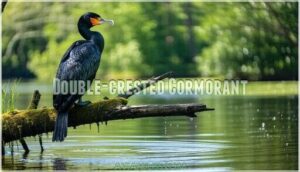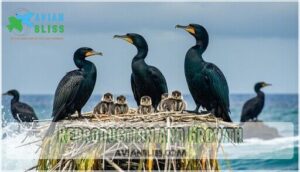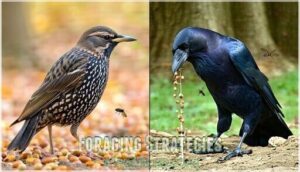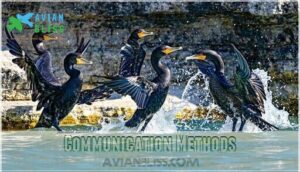This site is supported by our readers. We may earn a commission, at no cost to you, if you purchase through links.
 You’ll recognize the double crested cormorant by its sleek black body, bright orange throat pouch, and habit of perching with wings spread wide to dry.
You’ll recognize the double crested cormorant by its sleek black body, bright orange throat pouch, and habit of perching with wings spread wide to dry.
These skilled diving birds inhabit waterways across North America, plunging underwater to catch fish with remarkable precision. They’re social creatures that nest in colonies on islands, cliffs, and trees near water.
During breeding season, adults develop distinctive wispy crests that give them their name. While their populations have recovered from DDT-era declines, they now face new challenges from habitat loss and conflicts with commercial fishing operations that view them as competition.
Table Of Contents
- Key Takeaways
- Double Crested Cormorant Description
- Range and Habitat
- Nesting Habits
- Double Crested Cormorant Diet
- Reproduction and Growth
- Population and Conservation
- Double Crested Cormorant Behavior
- Double Crested Cormorant Predators
- Human Impact and Controversy
- Management and Regulation
- Frequently Asked Questions (FAQs)
- How rare is a double-crested cormorant?
- Is a double-crested cormorant a duck?
- What is the difference between a cormorant and a double-crested cormorant?
- Are cormorants an invasive species in the US?
- Are Double-crested Cormorants rare?
- Can you eat Double-crested Cormorants?
- What are the main predators of the double-crested cormorant?
- How long do Double-crested Cormorants live?
- What roles do Cormorants play in local ecosystems?
- How are Double-crested Cormorants affected by climate change?
- Conclusion
Key Takeaways
- You’ll recognize these skilled diving birds by their sleek black bodies, bright orange throat pouches, and distinctive habit of spreading their wings wide to dry after fishing
- You can find them across North America’s waterways where they’ve made a remarkable recovery from DDT-era population crashes, though they now face new challenges from habitat loss and fishing industry conflicts
- You’ll witness fascinating behaviors including cooperative hunting, elaborate courtship displays with zigzag swimming, and colonial nesting where both parents share duties raising their young
- You should know they’re protected under the Migratory Bird Treaty Act but remain controversial due to their substantial fish consumption – up to 77 million pounds annually in the Great Lakes alone – creating ongoing management challenges
Double Crested Cormorant Description
You’ll recognize the Double-crested Cormorant by its distinctive silhouette – a dark, heavy-bodied bird that sits low in the water with its long, kinked neck and hooked bill.
You’ll spot this master angler’s unmistakable profile gliding through waterways with predatory grace.
These water birds range in size between a crow and small goose, measuring 28-35 inches long with a wingspan reaching 48 inches, which makes them a distinctive sight, with their size being a notable characteristic.
Physical Characteristics
You’ll recognize a double crested cormorant by its distinctive physical characteristics that set it apart from other waterbirds.
This cormorant bird displays striking plumage coloration with adults showing jet-black feathers and immatures sporting brownish tones with whitish breasts.
Their bill morphology features a thin, strongly hooked tip roughly matching their head length, and their body size ranges between crow and goose dimensions.
Their unique leg placement sits far back on their frame, creating their characteristic low-water posture, which is a notable feature of this bird, showcasing its unique body size.
Identification Features
You’ll spot a double crested cormorant by its distinctive adult plumage – sleek black feathers contrasting with bright orange throat patches.
Immature markings show brownish tones with whitish breast areas.
The hooked bill morphology helps with fish-catching, while crest variations appear seasonally.
Size differences distinguish this cormorant bird from similar species, making bird identification easier through these clear physical characteristics and consistent color patterns.
Geographic Variations
You’ll find that Doublecrested Cormorant populations across North America display fascinating regional size and crest differences.
Western birds grow larger with whiter, straighter crests, while southeastern populations stay smaller with curly black head tufts.
These geographic variations reflect habitat adaptations and genetic diversity shaped by different migration routes.
Regional differences in bill length and body mass help cormorant species thrive in their local environments.
Range and Habitat
You’ll find Double-crested Cormorants across North America from coast to coast, making them the most widespread cormorant species on the continent.
They adapt to almost any water habitat you can imagine, from ocean coastlines to prairie lakes, rivers, and even small ponds.
Breeding Grounds
You’ll find Doublecrested Cormorant colonies spanning from Alaska to Florida’s Gulf Coast.
These birds show remarkable Site Fidelity, returning to familiar Colony Locations year after year.
Great Lakes house over 30% of breeding populations, with Nesting Density reaching hundreds of pairs per site.
Ground Nests and tree nests both occur, though Habitat Loss threatens traditional sites.
Smart birds adapt by colonizing new areas when old ones disappear.
Migration Patterns
Double-crested cormorants follow predictable bird migration patterns driven by food availability and weather changes.
These birds travel impressive migration distances along established flyway routes between breeding and wintering grounds.
Most populations migrate south for winter, though some remain year-round in suitable climates.
Migration Triggers and Patterns:
- Migration Triggers – Temperature drops and ice formation force birds south when fish become inaccessible
- Flyway Routes – Major pathways include Atlantic, Mississippi, Central, and Pacific corridors connecting breeding areas to wintering grounds
- Migration Distances – Birds travel 500-2,000 miles between summer and winter locations depending on population
- Wintering Grounds – Coastal areas from southern United States through Central America provide ice-free waters
- Stopover Ecology – Large lakes and rivers serve as essential refueling stations during long-distance flights
Favorite Nesting Sites
When double-crested cormorants choose nesting sites, they’re picky tenants with specific requirements.
These birds show strong site fidelity, returning to proven locations year after year.
Island preference tops their list, offering protection from ground predators during breeding season.
| Site Type | Benefits | Usage Pattern |
|---|---|---|
| Islands | Predator protection, isolation | Primary choice for colony breeding |
| Flooded Timber | Elevated platforms, cover | Secondary option in wetlands |
| Cliff Ledges | Height advantage, accessibility | Used in coastal regions |
Colony dynamics drive their selection process.
They favor spots where hundreds of pairs can gather safely.
Flooded timber provides excellent nest construction opportunities, while the social structure helps protect young birds from threats.
These birds often seek out locations suitable for cormorant nesting structures.
Nesting Habits
When you watch a Double-crested Cormorant colony during breeding season, you’ll notice these birds aren’t picky about their nesting materials.
They’ll build their stick platforms using everything from twigs and seaweed to fishing line, feathers, and even lost combs—whatever they can find near their waterfront real estate, which showcases their ability to use available resources, including fishing line.
Nesting Sites
You’ll discover these versatile birds adapting to various nesting sites with remarkable flexibility.
Cormorant colonies establish themselves on cliff ledges, tree branches, or ground locations near water sources.
Site fidelity runs strong as pairs often return to previous nest locations.
Colony location depends on habitat availability, with nest density varying from scattered pairs to thousands of birds.
Nest height ranges from ground level to treetops, showing their adaptable bird nesting behavior with a strong tendency towards site fidelity.
Unique Nesting Materials
You’ll be amazed by what double-crested cormorants consider prime building materials for their nests.
These resourceful birds don’t just stick to traditional twigs and branches. Nest composition includes everything from roots and weeds to unusual human debris like combs, feathers, and even pipes.
Material availability drives their choices, creating surprisingly durable structures. They may even incorporate suitable nest liners for added protection.
This adaptability in bird nest construction helps guarantee nest function across diverse environments.
Incubation and Young
After nest construction, you’ll witness fascinating bird reproduction patterns. Both parents share incubation duties for their bluish-white eggs over 25-33 days.
The chicks hatch ready for intensive parental care and feeding.
- Egg Coloration: Chalky bluish-white eggs often become stained from nest materials
- Parental Roles: Both adults take turns incubating and feeding duties equally
- Nestling Socialization: Young chicks wander through colonies after 3-4 weeks
- Fledgling Foraging: First flight occurs at 5-6 weeks with continued parental feeding
- Juvenile Independence: Complete independence achieved around 9-10 weeks of age
Double Crested Cormorant Diet
You’ll find that Double Crested Cormorants are skilled underwater hunters with a diet that changes based on what’s available in their environment.
These adaptable birds consume over 250 fish species plus crustaceans, amphibians, and other aquatic prey to meet their daily nutritional needs.
Primary Food Sources
You’ll find that fish make up the backbone of the cormorant diet, with these birds consuming over 250 different species daily.
Their fish consumption averages one pound per day, focusing on small forage fish like schooling varieties and bottom-dwellers.
Beyond their primary fish diet, cormorants show impressive dietary flexibility through crustacean intake including crabs and shrimp, amphibian diet featuring frogs and salamanders, plus mollusk variety and other aquatic life.
This seasonal prey adaptation helps them thrive across diverse water environments, showcasing their ability to adapt to different ecosystems with a varied aquatic life.
Foraging Behaviors
You’ll witness impressive foraging techniques when watching cormorant diet behavior.
These diving birds plunge 5-25 feet underwater, using powerful webbed feet for propulsion.
Their specialized hooked bills grab slippery fish with precision.
Cooperative hunting occurs when flocks work together, while unique prey processing includes hammering crustaceans before swallowing them headfirst.
Cormorants, like other birds, display diverse adaptation strategies to thrive in their environments.
Fascinating Foraging Facts:
- Diving depths reach up to 25 feet with 70-second breath holds
- Cooperative hunting flocks surround schools of fish together
- Prey processing involves flipping fish headfirst for easier swallowing
- Diet adaptations include using wings underwater for extra propulsion
- Foraging locations span from crystal-clear lakes to murky coastal waters
Diet Variations
Cormorants display remarkable seasonal diet flexibility across different regions.
Inland populations consume 90% freshwater fish like perch and bass, while coastal birds prefer marine species.
Regional differences show Baltic populations targeting flatfish, comprising 40% of their diet.
Prey size typically ranges 7-15 cm, with smaller fish preferred during chick-rearing.
Their feeding behavior adapts to foraging depth and habitat, including crabs, shrimp, and crayfish when fish become scarce, demonstrating significant dietary impact on local ecosystems.
Reproduction and Growth
You’ll discover that double-crested cormorants have a fascinating reproductive cycle that begins with elaborate courtship displays and ends with independent young birds ready to fish on their own.
These colonial nesters follow a predictable timeline from egg laying through fledgling development, with both parents sharing the demanding work of raising their chicks.
Breeding Season
You’ll spot double-crested cormorant breeding habits from April through July when these birds transform into romantic performers.
Their courtship display involves splashing wings, zigzag swimming, and impressive diving shows that would make any water acrobat jealous.
- Courtship Rituals: Males perform elaborate water dances with wing-splashing and diving displays to attract females
- Nest Building: Pairs construct platforms using twigs, roots, and unusual items like combs or pipes over four days
- Bird Breeding Cycles: Breeding typically begins at three years of age with colony nesting behavior
- Parental Care: Both parents share responsibilities from nest construction through feeding their future nestlings
Egg Laying
Between April and July, females deposit their egg clutch size of 2 to 7 chalky-blue eggs.
The eggshell coloration starts bright blue but often becomes stained brown from nest materials.
Laying frequency varies by location and food availability. This egg laying season coincides with peak fish abundance.
The nest staining from debris creates camouflage protection for developing eggs, which is crucial as it coincides with peak fish abundance, and the eggs are laid with a frequency that varies by location.
Nestling Development
After the eggs hatch, you’ll observe rapid bird chick development. Both parents provide constant parental care through frequent feeding sessions.
Young cormorants stay in ground nests for three to four weeks during their vital socialization period, then wander the colony while returning for meals. Nest architecture varies widely, with some species even utilizing spider silk for strength.
Nestling Development Stages:
- Feeding frequency – Parents deliver fish every few hours, with chicks consuming up to one pound daily
- Bird chick growth – Nestlings double their weight within two weeks through constant nutrition
- Bird chick socialization – Young birds interact with colony members, learning essential social behaviors
- Fledgling behavior – First flight attempts occur at five to six weeks, with awkward practice sessions
- Independence age – Complete bird chick independence arrives at nine to ten weeks when they join foraging groups
Population and Conservation
You’ll find that Double-crested Cormorant populations have made a remarkable comeback since the 1970s, with current estimates placing their numbers between 871,001 and 1,031,757 birds across the U.S. and Canada.
While their recovery represents a conservation success story, these adaptable water birds now face new challenges as their populations stabilize due to habitat limitations and ongoing conflicts with fishing interests, posing a threat to their well-being in the form of habitat limitations.
Current Population Estimate
You’ll find North America’s double-crested cormorant population sitting pretty at 2-2.4 million birds today.
The US Fish and Wildlife Service tracks around 250,000 breeding pairs annually through surveys and population counts.
These estimation methods reveal fascinating regional variations – the Great Lakes hosts nearly half of all breeding pairs.
After recovering from DDT-related crashes, population trends now show stabilization since 2015.
Data collection continues improving with satellite technology, helping scientists make future projections for cormorant populations.
Conservation Status
Nobody can deny that double-crested cormorant numbers have rebounded thanks to bird conservation and legal protections like the Migratory Bird Treaty Act.
Population trends now show stability, but Habitat Loss still poses risks.
Conservation Efforts focus on maintaining waterbird populations and healthy habitats. The Future Outlook for this bird species conservation is promising, if we keep supporting cormorant behavior research and management.
Threats and Challenges
Despite recent population growth, double-crested cormorants face mounting pressures.
Despite their remarkable recovery, these diving masters still battle habitat loss, climate shifts, and human conflicts that threaten their watery kingdoms.
Habitat Loss from development threatens nesting sites. Climate Change alters fish distributions, creating Food Scarcity.
Human Persecution continues through depredation permits at aquaculture facilities. Oil Spills devastate coastal populations.
Though environmental regulations banned DDT and chlorinated hydrocarbons, recovery remains uneven across regions, with some populations still struggling.
In Ohio, population control is used to manage their numbers, addressing Human Persecution and the need for population control.
Double Crested Cormorant Behavior
You’ll notice Double-crested Cormorants display fascinating behaviors that help them thrive in aquatic environments. These social birds use specific foraging techniques and communication methods to survive in their watery world.
Social Behavior
You’ll notice these birds aren’t loners – they’re colony creatures through and through.
Cormorant colony dynamics reveal fascinating bird social behavior patterns.
During breeding season, mating displays create temporary social hierarchy structures within the bird colony.
Males perform elaborate zigzag swimming and wing-splashing rituals to attract females.
Colony dynamics shift as pairs form and defend nesting territories.
Group defense mechanisms protect the entire bird colony from predators, while cooperative foraging behaviors help maximize fishing success for all members.
Foraging Strategies
You’ll discover these birds are masters of aquatic hunting. They employ various foraging strategies depending on conditions.
Diving depths reach 25 feet, with occasional plunges to greater depths. Cooperative hunting occurs when fish schools are abundant.
Their prey selection adapts to seasonal diet changes and habitat influence. As opportunistic feeders, they adjust bird feeding strategies based on available resources, making them successful diving birds with versatile bird prey capture techniques.
Communication Methods
You’ll notice several vocalization types when observing these birds communicate.
Double-crested cormorants use guttural grunts and croaks during mating signals and territorial disputes.
Visual displays include wing-spreading and head movements that complement their bird calls.
Chick communication involves persistent begging sounds that help parents locate offspring in crowded colonies.
During cooperative hunting, subtle body language coordinates group foraging behavior among this bird species, which is an example of complex social behavior.
Double Crested Cormorant Predators
Despite their impressive size and diving abilities, you’ll find that double-crested cormorants face threats from both aerial and aquatic predators throughout their lives.
These birds have developed smart strategies to protect themselves and their young, including choosing nesting sites that offer natural defenses against common threats, which is a key aspect of their natural defenses.
Main Predators
Double-crested cormorants face numerous predators that threaten both adults and young throughout their lifecycle. Avian predators like great horned owls, bald eagles, and ravens pose significant threats to this aquatic bird species.
Their diet consists primarily of fish, with daily consumption estimates ranging from 400-700 grams.
Mammalian threats include raccoons, foxes, and coyotes that raid nesting colonies. Aquatic dangers from large fish and snakes target swimming chicks.
- Nest predation by raccoons and crows causes substantial chick mortality in waterbird colonies
- Large raptors hunt adult cormorants in their seabird habitat during daylight hours
- Snakes and weasels infiltrate cormorant habitat to steal eggs from ground-nesting avian species
Predator Avoidance
Several effective strategies help cormorants stay one step ahead of danger.
Flocking Behavior creates safety in numbers, with multiple eyes scanning for threats. Their Camouflage Tactics include spreading dark wings to blend with shadows and remaining motionless when danger approaches.
Predator Recognition skills develop early, helping them identify aerial and aquatic threats. Chick Defense involves adults forming protective circles around young birds.
Smart Habitat Choice and strategic bird behavior maximize survival through effective avian behavior and animal behavior adaptations.
Nesting Site Selection
Smart double-crested cormorants choose nesting sites like seasoned real estate agents—location matters most. Their bird nesting habits reveal sophisticated site fidelity patterns that help avoid predators while meeting habitat requirements.
Strategic nesting site selection includes:
- Island locations – Natural barriers reduce ground predator access and human disturbance
- Elevated positions – Tree branches or cliff ledges provide escape routes from terrestrial threats
- Colony dynamics – Dense groupings offer protection through numbers and shared vigilance
- Resource proximity – Sites near productive fishing waters guarantee efficient food delivery to young
To further discourage avian interference, some property owners implement rooftop spike strips. These bird nesting behavior patterns demonstrate how habitat preference directly influences survival rates in cormorant colonies.
Human Impact and Controversy
You’ll discover that double-crested cormorants create significant tension between conservationists and fishing communities across North America.
Their growing populations have sparked heated debates about fish consumption, aquaculture damage, and wildlife management policies that affect both ecosystems and human livelihoods, particularly in terms of wildlife management.
Fishing Industry Impact
The double-crested cormorant’s voracious appetite creates ripple effects throughout wild fisheries.
These birds consume up to 77 million pounds of fish annually in the Great Lakes alone, triggering sport fish decline and commercial fishing losses.
When yellow perch populations collapsed in Michigan, local communities faced $5.3 million yearly losses, leading to fishery management conflicts over depredation permits and economic consequences for fishing-dependent regions.
Their population resurgence, however, has led to increased management efforts, resulting in commercial anglers now competing directly with cormorants for valuable stocks.
Aquaculture Effects
Fish farms face serious challenges from double-crested cormorant populations that can consume massive amounts of cultured fish daily.
Aquaculture operations report significant economic impacts when these skilled divers target their ponds. The aquaculture depredation order allows farmers to obtain depredation permits for population control measures.
However, habitat loss consequences exacerbate these conflicts as birds seek alternative food sources.
However, managing cormorant interactions with fish farms remains complex, requiring careful balance between protecting crops and preserving wildlife.
Conservation Efforts
You’ll find that bird conservation efforts for Double-crested Cormorants focus on balancing population stabilization with habitat preservation.
The MBTA protection has helped these birds recover remarkably since the 1970s. However, public perception remains mixed as fishermen worry about competition for fish resources.
- Habitat preservation protects nesting colonies on islands and coastal areas
- Population monitoring tracks bird population trends across North America
- MBTA protection shields cormorants from hunting and harassment
- Future threats include climate change affecting bird habitat conservation
Management and Regulation
You’ll find that managing Double-crested Cormorant populations involves careful balance between conservation needs and human concerns.
The US Fish and Wildlife Service oversees regulations through depredation orders and targeted control measures when these birds conflict with fishing operations or aquaculture facilities.
US Fish and Wildlife Service
You’ll find the US Fish and Wildlife Service manages double-crested cormorant populations through the Migratory Bird Treaty Act.
The agency provides MBTA protection while balancing conservation with fishing industry concerns.
Research funding supports population studies, and Flyway Councils help coordinate regional management.
The depredation permit system allows controlled population management when conflicts arise with aquaculture operations.
Depredation Orders
Federal agencies use depredation orders to authorize cormorant control when these birds damage aquaculture facilities or threaten public fisheries.
You’ll find these orders allow lethal take without individual permits, though courts vacated broad orders in 2016.
The depredation permit system now requires environmental reviews, and Flyway Councils help coordinate regional management while addressing economic impacts and environmental concerns about double-crested cormorant populations.
Population Control Measures
Management agencies use multiple strategies to control cormorant colony growth.
You’ll see these four primary approaches in action:
- Lethal control through shooting programs under the depredation permit system
- Nonlethal management using deterrents and harassment techniques
- Habitat modification with exclusion netting and structural barriers
- Fertility control via egg-oiling and nest destruction
Public perception influences which lethal take methods gain approval for population control efforts.
Frequently Asked Questions (FAQs)
How rare is a double-crested cormorant?
Double-crested cormorants aren’t rare at all.
You’ll find nearly a million breeding across North America, making them the continent’s most common cormorant species.
With populations that have actually increased since environmental protections began.
Is a double-crested cormorant a duck?
No, you’re looking at a water bird that’s not a duck at all.
Double-crested cormorants belong to a completely different bird family with unique hunting abilities and distinctive body features that set them apart.
What is the difference between a cormorant and a double-crested cormorant?
You’ll find that "cormorant" refers to the entire family of water birds, while "double-crested cormorant" names one specific species within that family, distinguished by its characteristic breeding crests.
Are cormorants an invasive species in the US?
No, cormorants aren’t invasive in the US.
They’re native birds protected under federal law since
Their populations recovered after DDT bans, leading some to mistakenly label them invasive when they’re simply naturally rebounding.
Are Double-crested Cormorants rare?
Current estimates show nearly one million Double-crested Cormorants inhabit North America.
You won’t consider them rare since their populations have actually grown substantially since environmental protections began in the 1970s, making them quite common today.
Can you eat Double-crested Cormorants?
You can’t legally eat Double-crested Cormorants in North America. They’re protected under the Migratory Bird Treaty Act since 1972, making hunting or consuming them illegal without special permits.
What are the main predators of the double-crested cormorant?
Like guardians watching over a treasure chest, predators threaten Double-crested Cormorants at every life stage.
You’ll find raccoons, foxes, and coyotes raiding ground nests for eggs and chicks, while Great Horned Owls and Bald Eagles hunt both juveniles and adults from above.
How long do Double-crested Cormorants live?
You’ll find that these birds typically live 6 to 10 years in the wild, though some individuals can reach up to 17 years with favorable conditions and adequate food sources.
What roles do Cormorants play in local ecosystems?
Think of cormorants as nature’s underwater janitors – they’re essential cleanup crews in aquatic ecosystems.
You’ll find they control fish populations, transfer nutrients between water and land, and create nesting habitats that other waterbirds share for breeding success, making them a crucial part of the ecosystem as nature’s underwater cleanup crews.
How are Double-crested Cormorants affected by climate change?
Climate change forces these birds to shift their range northward as warming waters alter their habitat. Only 21% of their core summer area remains stable by 2080, pushing them into new territories.
Conclusion
How can we protect these remarkable waterbirds while balancing human needs?
You’ve learned that the double crested cormorant faces complex challenges requiring thoughtful management.
Their recovery from DDT poisoning shows conservation success, yet conflicts with fishing industries persist.
You can support these birds by understanding their ecological role and advocating for balanced policies.
Habitat protection remains essential for sustaining healthy populations.
The double crested cormorant’s future depends on continued monitoring, research, and collaborative conservation efforts that respect both wildlife needs and human activities.
- https://www.aphis.usda.gov/sites/default/files/Cormorants-WDM-Technical-Series.pdf
- https://www.ideastream.org/news/environment-energy/2021-01-14/reducing-double-crested-cormorant-population-an-ethically-challenging-necessity
- https://www.glfc.org/pubs/lake_committees/ontario/cormorant.pdf
- https://digitalcommons.unl.edu/cgi/viewcontent.cgi?article=1232&context=icwdm_usdanwrc
- https://www.allaboutbirds.org/guide/Double-crested_Cormorant/lifehistory
















